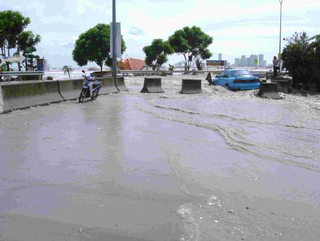| This article needs to be updated. Please help update this article to reflect recent events or newly available information. (November 2010) |

Malaysia was affected by the 2004 Indian Ocean earthquake and tsunami on 26 December 2004. Despite its proximity to the epicentre of the earthquake, Malaysia escaped the kind of damage that struck countries hundreds of miles further away. Since the epicentre was on the western coast of Sumatra, the island largely protected the country from the worst of the tsunami.
Tsunami
The areas hardest hit were the northern coastal areas and outlying islands like Penang and Langkawi. Wave heights near the shore were 2.5–3 m (8.2–9.8 ft) for Langkawi and 2–3 m (6.6–9.8 ft) for Penang, where wave runup heights were 6–8 m (20–26 ft) in one location. In some areas of Malaysia the tsunami reached 3 km (1.9 mi) inland. Houses in fishing villages along coastal areas were damaged in Batu Ferringhi and Balik Pulau in Penang. Coastal areas in Peninsular Malaysia e.g. 13 villages in Kuala Muda, Kedah and Kuala Triang in Langkawi island were also affected. About a quarter of holiday vessels anchored in Rebak and Telaga harbour in Langkawi were also damaged. The waves sent parked motorcycles crashing and cars washed with mud at stretches along Gurney Drive in George Town, Penang. The biggest loss from a single family was when five of Zulkifli Mohamad Noor's seven children were killed when the tsunami struck at Pasir Panjang beach. Sinkholes which were reported in Kampar and Ipoh for three days running have been investigated and determined not to be earthquake related.
Aftermath

The then-Prime Minister, Dato' Seri Abdullah Ahmad Badawi, cut short his holiday in Spain after five days of the diplomatic trip to India and returned to Malaysia. He instructed the government to cancel all New Year celebrations and urged all parties, including the private sector, to hold prayers and remembrance services instead. The government also postponed the deportation of illegal immigrants and extended an amnesty so that they may exit the country by 31 January 2005 instead of 31 December 2004. It was announced that MYR 1,000 (US$260) would be given to the families of victims while MYR 200 (US$50) would be paid to those who had sustained injuries from the tsunami. Displaced residents would be given MYR 200 to alleviate their hardship, MYR 2,000 for every house damaged, and MYR 5,000 for every destroyed house. Fishermen whose boats were lost would be given MYR 1,000 for smaller boats and MYR 3,000 for larger boats.
Death toll
The number of deaths currently stands at 67 with 52 in Penang, 12 in Kedah, 2 in Perak and 1 in Selangor. The deaths at Penang were reported to include many picnickers and children who were playing on open public beaches. No deaths were reported among foreign tourists.
References
- Moon 1,2, Sidek 1, Lau 3, Puay 4, Majid 3, Wahab 5, Teo 6, Wei Chek 1,2, Lariyah Mohd 1, Tze Liang 3, How Tion 4, Taksiah Abdul 3, Ahmad Khairi Abd 5 and Fang Yenn 6 (8 August 2022). "A Shared Vision on the 2004 Indian Ocean Tsunami in Malaysia: Hazard Assessments, Post-Disaster Measures and Research". Journal of Marine Science and Engineering. 10 (8): 1088. Bibcode:2022JMSE...10.1088M. doi:10.3390/jmse10081088.
{{cite journal}}: CS1 maint: multiple names: authors list (link) CS1 maint: numeric names: authors list (link) - "Malaysian National News Agency :: BERNAMA". bernama.com. Archived from the original on 27 January 2005.
- "2004 Indian Ocean Tsunami in Malaysia". encyclopedia.pub. Retrieved 2 March 2023.
External links
- Tsunami in Penang Malaysia, video taken on 26 December Archived 15 January 2005 at the Wayback Machine (WMV file)
- The only Online Neighbourhood Community with an organised and central Tsunami Aid Programme
- Tsunami Disaster in Malaysia : Missing persons and updates
- Tsunami Tragedy Updates
- Visit to Kota Kuala Muda
- Tsunami Aftermath in Penang
- Statistics of Tsunami Aftermath
| Regional humanitarian situation due to the 2004 Indian Ocean earthquake and tsunami | |
|---|---|